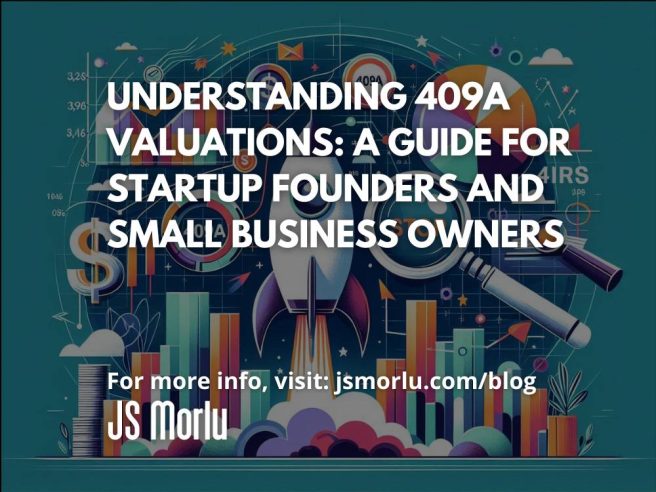By: John S. Morlu II, CPA
You’ve just launched your startup—congrats! The future is full of possibilities. You’ve assembled an awesome team, cooked up a killer product idea, and maybe even charmed a few angel investors into believing in your dream. Life is good, right? But then, during a pivotal meeting or a casual chat with a potential investor, someone drops a bombshell: “So, what’s your 409A valuation?”
Cue the awkward silence. You mentally scramble through everything you’ve learned as a founder, but “409A” sounds like a robot name from a low-budget sci-fi flick. Is it a tax form? A new social media platform? Should you nod and pretend you know, or quietly Google it under the table?
Fear not, my brave founder! The 409A valuation may sound like something out of a legal thriller, but it’s actually a critical part of startup life. And the best part? You don’t have to be a finance guru to get it. By the end of this article, not only will you fully understand what a 409A valuation is, but you’ll also be able to drop it casually into conversations with investors like you’ve been talking about it your whole life.
We’re going to break it down step by step—no jargon, no headaches, just a mix of practical insights, fun facts, and the occasional laugh to keep things light. Whether you’re in the early pre-seed hustle or planning a glorious IPO, the 409A valuation matters to you, your team, and yes, even your future unicorn status. So buckle up, because this is going to be the most entertaining ride through tax compliance and stock options that you’ll ever take. Trust me—you’ll walk away smarter and maybe even chuckle once or twice. Let’s dive in!
What is a 409A Valuation Anyway?
The term “409A valuation” might sound like something only a tax accountant would mutter over a third cup of black coffee while poring over spreadsheets. But surprise—it’s actually something you, the brave startup founder, need to care about too! No, it’s not a secret handshake or a cryptic IRS code designed to confuse. In reality, it’s a key part of your company’s growth, and understanding it can save you a world of hurt down the line.
So, what exactly is a 409A valuation? Imagine it as the official price tag on your company’s common stock, determined by an independent third party. Essentially, it’s an impartial appraisal of your company’s fair market value (FMV)—a way to figure out what your company’s stock is worth at this very moment. Think of it like Zillow for your startup’s shares, except instead of a real estate agent, you’ve got finance wizards calculating your worth.
Now, why do you need this magical valuation? Well, picture this: You’ve got a hotshot employee ready to join your team, and you want to offer them stock options as part of their compensation package. Under IRS rules, those stock options need to be priced at or above the current FMV of your company’s common stock. That’s where the 409A valuation swoops in to save the day. If you price the stock too low, you’ll have the IRS breathing down your neck, threatening penalties and audits. But if you price it too high, your employees might not be able to afford their options, leaving you with a team that’s a little grumpy about their compensation package. Not exactly the “go team” vibe you’re looking for.
So yes, while “409A valuation” might sound like an obscure tax law that’s best left to accountants, it’s actually a crucial tool in your startup toolkit. You’ve got stock options to issue, employees to keep happy, and tax penalties to avoid. Now, let’s dive into the nitty-gritty and see why this seemingly dry piece of financial jargon is the secret sauce to keeping your company—and your team—on the right track.
But don’t worry, we’ll keep it fun along the way. After all, tax regulations and startup valuations should be as enjoyable as figuring out your next product pivot, right? (Okay, maybe not that fun, but stick with me.)
Fun Fact #1: 409A Was Born From Scandal
Surprise, surprise! Like many dramatic twists in history, the 409A regulations were born out of—wait for it—corporate scandals. Yes, think less “innovative tax law” and more “financial soap opera.” Cast your mind back to the early 2000s, when companies like Enron and WorldCom were making headlines for all the wrong reasons. These corporate giants became infamous not just for creative accounting (ahem, fraud) but for wildly mismanaging stock option pricing. It was basically the Wild West of finance—where the rich got richer, and employees and investors were left clinging to the wreckage.
Here’s how it went down: These companies awarded stock options to employees at laughably low prices. Think of it as buying a brand-new Ferrari for the price of a used skateboard. Not too shabby, right? But when the companies imploded due to other shady dealings, the stock options became worthless. Employees and investors got burned, while executives casually sailed off into the sunset on their golden parachutes.
Well, the IRS—never a fan of watching cash evaporate—decided enough was enough. In came Section 409A to ensure that stock options couldn’t be priced at whatever bargain-basement value the execs felt like that day. The goal was to prevent future financial free-for-alls and ensure that stock options were based on the real value of a company’s common stock, so employees wouldn’t get stuck holding worthless options when things went south.
So, next time you’re filling out those 409A forms or sitting through a valuation meeting, just remember—you’re part of a legacy that started with scandals and billion-dollar collapses. It’s almost glamorous when you think about it. Well, if your idea of glamour involves tax codes and corporate greed. But hey, at least you’re now playing by the rules that keep everyone honest… or at least closer to it!
Why Do You Need a 409A Valuation?
Picture this: You’ve just hired some rockstar developers and designers—think of them as the Avengers of your startup team. They’re excited, you’re excited, but there’s just one tiny hiccup: You’re not exactly swimming in cash yet. So, instead of offering them massive salaries, you dangle a more appealing carrot—stock options! It’s the ultimate startup incentive: “Sure, we can’t pay you now, but in the future, you could be sipping margaritas on a yacht, thanks to these stock options!”
But, hold up! Before you start handing out stock options like candy at Halloween, you need to know one very important thing: what those stock options are actually worth. This is where the 409A valuation swoops in like a financial superhero (or maybe just an accountant with a cape) to determine the exercise price—the price at which your team can buy the stock.
Here’s why this matters: If that price is set too low, the IRS might give you the stink eye. And by “stink eye,” I mean significant penalties for your company and extra taxes for your employees. It’s like offering your team the keys to the kingdom, only for them to find out the castle is haunted—yikes! Not exactly the dream scenario when you’re trying to build a motivated, loyal workforce.
But wait, there’s more! If you’re planning to raise some venture capital (VC) or plotting your grand exit strategy through a merger or IPO, investors will want to see your stock’s valuation. Why? Because they need to know if your company is a rocket ship about to take off or a paper airplane struggling to stay in the air. A proper 409A valuation gives them the inside scoop on your company’s financial health and potential—kind of like getting a sneak peek under the hood of a fancy sports car before they buy it.
So, the next time you think about skipping the 409A valuation, remember: It’s not just a formality, it’s the key to making sure you don’t get whacked by penalties, your employees aren’t hit with surprise taxes, and your investors feel confident that your startup is the real deal. Plus, let’s be honest—you don’t want to be the startup founder who hands out stock options with all the best intentions, only for it to blow up in everyone’s face. Not the kind of plot twist anyone wants in their startup journey!
409A Valuation vs. Fair Market Value (FMV)
One of the biggest misunderstandings out there is thinking that the 409A valuation is the same as your company’s overall Fair Market Value (FMV). It’s like assuming a minivan is the same as a Ferrari because they both have four wheels. Close, but definitely not the same thing.
The FMV is the grand total of your company’s worth—everything, soup to nuts. It’s like asking, “What would someone pay if they were to buy my company today?” Think of it as the all-in, everything-must-go sticker price of your business. But a 409A valuation? That’s a little more focused. It specifically deals with the value of common stock—the kind of stock you hand out to employees when you can’t quite pay them what Google or Meta might. Spoiler alert: this common stock is usually worth less than the fancy, VIP preferred stock that investors hold. And here’s why.
Preferred stockholders are like the VIP guests at a sold-out concert. They get all the perks: backstage passes, free merch, and, most importantly, liquidation preferences. If your company sells or exits, these folks get their money back first. They’re sipping champagne while the common stockholders (i.e., employees) are still waiting in line for their entry wristbands. If there’s money left after the VIPs cash out, then the common stockholders get their turn.
Because employees (the common stockholders) are at the end of this payout line, the common stock is valued lower than preferred stock. After all, the risk of getting nothing at all is higher. And that’s why your 409A valuation reflects a lower value—it’s pricing the stock options you’re giving to employees, not the entire company or the stock that investors hold. It’s like selling the regular tickets to the concert, not the platinum, meet-the-band, front-row seats.
So next time you’re looking at a 409A valuation, don’t confuse it with your company’s FMV. Think of it as comparing two totally different seats on the startup rollercoaster: the cushy VIP ride for investors and the employee ride, which—while still fun—comes with a bit more jostling.
IRC 409A Valuation Requirements: The Rulebook You Never Knew You Needed
Alright, buckle up—time to dive into the IRC 409A Valuation Requirements, a topic that’s usually about as exciting as watching paint dry. But stick with me, and we’ll try to make it a little more entertaining. After all, tax code can be thrilling when you know what’s at stake (spoiler alert: it’s your startup’s future!).
So here’s the deal: Section 409A of the Internal Revenue Code (yes, the very same code that probably inspired more than a few accountants to develop caffeine dependencies) lays out some very specific rules about how stock options need to be valued. Think of it as the IRS’s way of making sure nobody gets too creative when it comes to stock option pricing. They’re like that strict referee in a soccer game, making sure everyone plays by the same rules—no cutting corners, no sneaky moves.
The most important rule? Stock options must be issued with an exercise price equal to or greater than the Fair Market Value (FMV) of your common stock on the exact day the options are granted. You heard that right. It’s not “around the time” or “a week after”—it’s on the actual day. Because let’s be real, the IRS isn’t into guesstimates. They want precision, like a finely tuned machine (or, more realistically, a tightly monitored spreadsheet).
But why so picky? Well, imagine this: If you gave your employees stock options at a price lower than the company’s actual value on that day, you’d essentially be giving them a gift-wrapped, deep-discounted stock deal. Sounds great for the employees, right? Sure, until the IRS steps in like a very unimpressed teacher catching someone cheating on a test. The penalties can be brutal, like “go directly to jail, do not pass Go” in Monopoly—except instead of jail, it’s crippling taxes and penalties for both your company and your employees. Not fun.
So, think of this rule as the IRS’s way of ensuring that everyone is playing fair. They don’t want you giving your employees an unfair advantage, and they certainly don’t want to lose out on their tax cut. And the timing is everything—there’s no “winging it” when it comes to 409A valuations.
Of course, this is where your friendly neighborhood 409A valuation firm steps in. They help you nail down the FMV so that when you grant those stock options, you do it by the book, and the IRS remains happy (or, at the very least, uninterested in auditing you). It’s kind of like hiring a wedding planner to make sure you don’t forget any of the important details on your big day. No one wants to get to the altar and realize they forgot the rings. And trust me, you definitely don’t want to hand out stock options without getting that 409A valuation just right. The stakes are high, and penalties are a one-way ticket to Taxpayer’s Regret—not a destination anyone wants to visit.
So, the moral of the story? Get that 409A valuation done before you grant any stock options, because when the IRS is involved, there are no do-overs.
409A Valuation at Different Funding Stages: The Roller Coaster of Startup Value
As your startup goes through different funding rounds, your 409A valuation takes a journey that could rival a roller coaster at an amusement park. From “barely worth a pizza party” at pre-seed to “someone get us a yacht” at Series C, the valuation of your company grows as you do. But what does that mean for your stock options? Let’s hop on and take a ride through the various funding stages—and I promise, this will be way more fun than decoding tax regulations.
1. Pre-seed Rounds
Ah, the pre-seed stage—your startup is nothing more than an idea, a PowerPoint deck, and maybe a team that shares one overworked laptop. Revenue? What’s that? At this point, you’re surviving on the triple threat of bootstrapping, friends-and-family money, and maybe a couple of angel investors with more faith in you than you have in yourself. The good news? Your 409A valuation will likely be lower than the price of lunch in San Francisco, making stock options super affordable for your early employees.
Fun Fact: At the pre-seed stage, your valuation can be so minimal that it’s almost symbolic. If your 409A valuation were a car, think well-loved, slightly rusty, but still runs (most of the time). It’s low, but hey, so is the risk to employees coming in early—they’re getting in on the ground floor!
2. Seed Rounds
By the time you hit the seed round, you’ve started to gain some traction. You’ve probably got a working prototype, maybe a few early customers, and you’ve moved from ramen noodles to the occasional takeout burrito. Investors are beginning to take you a little more seriously (they’ll even return your calls now!), and you’re raising capital to refine your product and business model.
The 409A valuation during the seed round is still on the lower end, but it’s creeping upward. There’s a little less risk now, so employees who snag stock options here are still getting a great deal. It’s kind of like buying a concert ticket before the artist goes mainstream—you’re in at a bargain, and there’s a lot of upside potential.
3. Series A Rounds
Series A is where things start getting real. You’ve proven that your business model works, you’ve got users who actually like your product, and maybe—just maybe—you’ve even seen some revenue. Investors are getting serious now, and the checks are a bit bigger. But with great funding comes a higher valuation.
At this stage, your 409A valuation will jump, but it’s still reasonable enough that stock options are a killer perk for employees. The difference between the 409A valuation and preferred stock (the fancy stock investors hold) starts to show more clearly now. But hey, as long as you’re growing fast, those options will still be worth sticking around for.
4. Series B Rounds
Welcome to Series B—where it’s all about scaling. Your product works, people want it, and now you’re raising a chunk of capital to expand. Maybe you’re opening new offices, or perhaps you’re just trying to keep up with the sudden demand from customers who can’t get enough of your offering. Either way, your company’s valuation is rising like a soufflé (let’s hope it doesn’t deflate!).
By now, your 409A valuation is much higher, reflecting your company’s established market presence. Stock options are still a good deal, but they’re no longer the irresistible bargain they were in the early days. You might need to get creative with compensation strategies to keep the perks attractive for new hires—think performance bonuses, or maybe a ping pong table if all else fails.
5. Series C Rounds
Now we’re talking. By Series C, your startup is a well-oiled machine—you’re raising big money, and you might even be preparing for an IPO. Your 409A valuation is soaring, potentially hundreds of millions, maybe even billions. At this point, your company’s value is so high that stock options, while still valuable, are starting to feel more like investing in a blue-chip stock than a scrappy startup.
For employees, this is the moment they’ve been waiting for. Those stock options they grabbed back at the seed round? They’re now worth enough to finance a small island, or at least a really nice car. You, the founder, are probably thinking about the next chapter—should you head for the exit, or go for unicorn status?
6. Customized
And then there are the startups that don’t follow the traditional path. Maybe you’ve been bootstrapping longer than most, or perhaps you raised capital through some unique channel like crowdfunding or strategic partnerships. In these cases, a cookie-cutter 409A valuation won’t cut it.
A customized 409A valuation takes into account all the weird and wonderful factors that make your company unique. Did you secure a partnership with a Fortune 500 company? Do you own some game-changing intellectual property? These elements all factor into a bespoke valuation process that ensures your stock options are priced fairly, but uniquely.
No matter what funding stage you’re in, your 409A valuation is crucial for keeping your startup compliant, your employees happy, and the IRS off your back. And remember, this number isn’t just about taxes—it’s a snapshot of where your company stands on its wild, unpredictable journey to success. So the next time you think about your 409A valuation, don’t just see it as a tax requirement—think of it as a signpost on your path from scrappy startup to world-changing enterprise!
The Three ‘Safe Harbor’ Methods: Choose Your Weapon Against IRS Penalties
When it comes to 409A valuations, it’s a game of chess with the IRS. Make the wrong move, and you could find yourself facing some hefty penalties. But don’t worry, the IRS has offered a bit of a cheat code with the Three “Safe Harbor” Methods. Think of them like different shields you can use to protect yourself from tax trouble. Let’s break down these options so you can decide which one fits your company’s unique (or chaotic) situation.
1. The Independent Appraisal Method: Your Golden Ticket
This is the gold standard of 409A valuation methods—and, yes, it’s the one that’ll make your CFO sleep soundly at night. You bring in a third-party expert to do the heavy lifting. They evaluate your company’s stock, crunch numbers, and then hand over a valuation report that’s as solid as a brick house.
Why is it the go-to? Because if you’ve got this valuation in hand, it’s hard for the IRS to say, “Wait a minute… are you sure your startup is only worth that?” It’s like showing up to a poker game with a royal flush. Not much anyone can do but respect it.
Pro Tip: If you’ve raised some serious capital and your company’s story has gone from “two friends in a garage” to “we just might take over the world,” the Independent Appraisal Method is your best bet.
2. The Formula-Based Method: For the Simplicity Lovers
If your company’s financials are straightforward—like, really straightforward—you might want to consider the Formula-Based Method. The idea is simple: use a predetermined formula (for instance, 1x annual revenue) to determine your valuation. It’s quick, it’s easy, and there’s less paperwork.
But, here’s the catch: startups usually hate this method. Why? Because, unless you’re running a lemonade stand, startup revenues are about as predictable as a toddler on a sugar high. One minute, you’re burning through cash like you’re trying to stay warm in a blizzard, and the next, you’re closing deals faster than you can count. The formula method works better for companies where things are a bit more… stable (whatever that means).
Fun Fact: This method is kind of like using a “Life Hack” from the internet—it seems cool and quick, but often, it’s not the right fit for startups with all their glorious unpredictability.
3. The Illiquid Startup Method: For When You’re Just Getting Started
Picture this: you’re an early-stage startup with a lot of potential, but not much in the way of financial history or liquidity. No one’s trading your stock yet, and the idea of an independent appraisal feels like overkill. Enter the Illiquid Startup Method. This one’s more of a fallback option, reserved for companies still finding their way through the fog of startup life.
It’s not as common as the Independent Appraisal Method, but it’s a handy tool when your startup isn’t quite ready for the big leagues yet. Just know, it’s a bit like wearing floaties in the deep end of the pool. It’ll keep you afloat, but you’re not exactly winning any races.
Fun Fact #2: Like milk left out of the fridge, your 409A valuation has an expiration date. It’s typically good for 12 months, or until a major event occurs (like closing a big funding round, acquiring another company, or landing that one client you’ve been dreaming about). Once that happens, the clock resets, and it’s time for a fresh valuation.
So, Which Method is Right for You?
If your startup is getting bigger and more complex, stick with the Independent Appraisal Method—it’s the IRS equivalent of a Teflon shield. For those rare companies with clear, simple finances, the Formula-Based Method could work—just remember, simplicity can be a luxury in startup life. And if you’re still finding your footing, the Illiquid Startup Method will keep you compliant without too much fuss.
No matter which method you choose, just know that 409A valuations are the key to avoiding IRS penalties and keeping your employees excited about stock options. So, pick your “safe harbor” wisely and steer your startup ship toward tax-compliant success!
How is a 409A Valuation Done?
Alright, buckle up because we’re about to venture into the wild world of 409A valuations. It might sound like an accountant’s dream party, but this is where the magic—or, let’s be real, a lot of number-crunching—happens. When a third-party firm conducts a 409A valuation, they don’t just eyeball it and throw out a number. No, they follow a tried-and-true process that involves three main valuation approaches. Let’s break them down, one by one, with a little flair to keep things interesting.
1. The Market Approach: Looking for Your Startup’s Doppelgänger
Imagine your company’s value is like picking out an outfit—you want to know what other people in your industry are wearing before you step out the door. The Market Approach works the same way. The valuation firm looks around and asks, “What are similar companies in the same industry and growth stage worth?” They’re basically checking out the competition to see if there’s a close match, aka “comps” (short for comparable companies).
This method is super helpful when your startup has sibling companies—those in your industry, about the same age, with similar levels of hype. If your company is like a young, scrappy disruptor in fintech, the valuation firm will find other fintechs to compare you to.
Pro Tip: If your industry is hot and full of rockstars, your valuation could see a little glow-up based on those comps. But if your sector’s struggling, well, maybe consider sweatpants for the day.
2. The Income Approach: Predicting the Future, Crystal Ball Style
If only we could all predict the future like a startup wizard! That’s kind of what the Income Approach attempts to do—estimate your company’s future earnings potential. The valuation firm takes your financial projections (think: “We’re gonna be the next Apple in five years!”) and works some math magic to estimate your company’s current value based on those projections.
Here’s the kicker: they also account for risk. Because let’s face it, startups are like rollercoasters—wild, unpredictable, and occasionally terrifying. They’ll discount future cash flows to reflect the idea that not every ambitious plan pans out exactly as you’ve hoped. It’s like saying, “Sure, you might own Mars one day, but right now, you’re mostly selling hope.”
Fun Fact: The Income Approach is like startup optimism in Excel form. Just be ready for the valuation firm to reign in some of your wilder predictions.
3. The Asset Approach: Counting Your Treasure Chest (But Not the Dream Castle)
This one’s a bit more straightforward, but not really a startup’s best friend. The Asset Approach values your company based on what you actually own. It’s kind of like looking at your company’s balance sheet and saying, “What’s left if we sell everything we own and pay off all our debts?”
For many startups, the result is… not much. Early-stage companies are often running on intangible assets like brilliant ideas, proprietary tech, or a groundbreaking algorithm that’ll change the world (but is still in beta). Unless your company has been hoarding some physical gold or fancy real estate, the Asset Approach might not give you the number you’re hoping for. But hey, it’s still a part of the process!
Pro Tip: If your startup is just getting off the ground and your “assets” are mostly in Post-it notes and laptops, don’t worry if this method doesn’t work in your favor.
The 409A Valuation Cocktail: A Blend of Methods
Here’s the thing: valuing a startup isn’t a one-size-fits-all situation. A solid 409A valuation usually involves a mix of these approaches. Depending on your company’s stage, industry, and financial quirks, the valuation firm might combine the Market, Income, and Asset Approaches to cook up a final number.
But here’s the fun part—there’s no exact formula. Two independent valuation firms might come up with slightly different numbers. It’s like asking two bartenders to make the same cocktail—each one might pour just a little differently.
Fun Fact #3: There’s no “Magic Number” when it comes to 409A valuations. That means founders should definitely get involved. By providing accurate financials, solid projections, and maybe a touch of realism, you can help guide the valuation process and end up with a number that reflects your company’s true worth—without the IRS giving you the stink eye.
So there you have it—the inner workings of a 409A valuation! It’s a bit like crafting the ultimate dish: part science, part art, a dash of optimism, and a healthy sprinkle of reality checks. And with this knowledge, you’re one step closer to understanding how the magic behind your startup’s valuation happens—without losing your mind in a sea of spreadsheets!
What Happens if You Don’t Get a 409A Valuation?
Ah, the temptation to skip your 409A valuation—especially when you’re hustling to build your product, stretch every dollar, and maybe not think about IRS compliance. But skipping out on a 409A is like deciding you don’t need an umbrella in a storm. Sure, you might get lucky, but most likely, you’ll end up soaked and miserable. And when it comes to the IRS, that storm comes with tax penalties.
Here’s the deal: without a proper 409A valuation, the IRS could argue that the stock options you gave your employees were granted at below Fair Market Value (FMV). You know what that means? The IRS starts tossing around scary phrases like “deferred compensation” under Section 409A, and that’s when things go downhill faster than your uncle’s attempt to explain crypto.
Let’s Talk About the Ugly Stuff:
When employees get stock options at below-FMV prices, it’s bad news. Why? Because under Section 409A, they could get taxed right away—yep, at the time of the grant, not when they eventually exercise their options (i.e., cash in when your company’s doing great). Imagine paying taxes on something you don’t even have in hand yet! That’s like buying a house and getting taxed on the potential value before it’s built.
But wait, there’s more: those same employees get hit with an extra 20% penalty tax on top of the regular taxes! That’s the kind of number that’ll make anyone reconsider the whole “startup equity” thing.
Now imagine trying to rally your team with a “Hey guys, I know we’re working 100 hours a week for stock options that will hopefully be worth millions, but first, you owe the IRS a chunk of change for stock you haven’t even touched.” Motivational speech of the century? Not quite.
Founders, You’re Not Safe Either
It’s not just the employees who suffer. Founders, you’re playing with fire too. Skipping the 409A opens your company up to potential IRS audits and penalties that could cost more than getting that valuation done in the first place. The last thing you want is to be explaining to investors why half your runway just disappeared because of an IRS penalty. Spoiler alert: it’s not the kind of “high-growth potential” they signed up for.
In short, skipping the 409A is a lose-lose situation: unhappy employees, potential tax nightmares, and an IRS with its magnifying glass hovering over your business. No one wants that.
Fun Fact #4: Valuations Can Be Optimistic—But Don’t Push Your Luck
It’s perfectly natural for founders to want a low 409A valuation. After all, the lower the valuation, the lower the price at which employees can buy stock options. This means your team can get a bigger slice of the pie without feeling like they’re auctioning off a kidney. However, artificially driving your valuation into the basement? That’s a major red flag for the IRS.
That said, if you’re an early-stage startup, don’t panic if your valuation feels lower than your wildest unicorn dreams. It’s supposed to be that way! Low valuations reflect the current stage—risk, uncertainty, and lack of revenue. Just because your 409A valuation doesn’t scream “the next SpaceX” doesn’t mean you’re not headed for greatness.
Think of your 409A as valuing the common stock based on where you are today, not where you hope to be in the future. It’s like when your mom took a picture of you on the first day of school—sure, you might have had a terrible haircut and braces, but you were full of potential!
So, while it’s fun to dream of a multi-billion-dollar valuation, for now, let the 409A reflect your company’s humble beginnings. It’ll pay off when employees can buy stock at a bargain, and the IRS doesn’t come knocking with a “what were you thinking?” penalty notice.
Moral of the story: Get your 409A valuation done. Avoid IRS doom. Let your team enjoy their stock options without the stress of taxes they don’t even know they owe yet. And remember: low valuation now doesn’t mean low potential forever. Keep building, and the next valuation might just have a few extra zeroes on it.
How Often Should You Do 409A Valuations?
Ah, the million-dollar question! So how often should you be rolling up your sleeves and diving into the world of 409A valuations? The short answer: typically every 12 months. But wait—there’s more!
Your 409A valuation is like a carton of milk; it has a shelf life! If you want to avoid that sour taste (and potential IRS scrutiny), keep an eye on your valuation and make sure it doesn’t expire. Besides the yearly checkup, you’ll need to reevaluate after any major material events. Think of material events like birthday parties: if you raise a new round of funding, acquire another company, or achieve a significant business milestone, it’s time for a valuation refresh!
But don’t worry! This doesn’t mean you need to stress about it like it’s an impending tax deadline. Treat your 409A valuation like a friendly reminder on your calendar—one that pops up, waves a little flag, and says, “Hey there! Time to check in on your company’s worth and make sure everyone is on the same page!”
Wrapping Up: Why 409A Matters to Your Startup’s Success
At the end of the day, a 409A valuation is like that unassuming superhero lurking in the shadows of your startup’s journey. It’s not just a box to check for tax compliance; it’s about nurturing a fair and equitable relationship with your employees. Think of it as a secret sauce that adds flavor to your company culture—by setting the right price for stock options, you incentivize your team to join the quest for success and avoid those pesky tax pitfalls that can rain on your parade.
Now, I know what you’re thinking: “Isn’t the 409A process just a big, scary monster hiding under my desk?” But fear not! While it may seem daunting, consider it a necessary rite of passage on your path to scaling your company with confidence. Just like your high school drama class prepared you for the real world—minus the awkward monologues.
So, the next time someone asks, “What’s your 409A valuation?” instead of hearing crickets chirping in the background, you’ll be ready to dazzle them with your knowledge! You can throw in a fun fact, like how it’s a critical step in keeping your startup’s financials on the up and up, and then maybe drop a joke about how the IRS loves to play hide and seek (spoiler: they always find you).
Whether you’re in the pre-seed phase, surrounded by dreams and ramen noodles, or navigating the wild waters of a Series C round, securing a proper 409A valuation is essential. It’s your ticket to not only staying compliant with IRS regulations but also ensuring your employees are motivated and fairly compensated. Because let’s be real—happy employees are like unicorns in your startup kingdom; they’re rare and sparkly, and everyone wants one!
As your startup evolves and grows, so will your 409A valuation. Just like that awkward teenage phase, it’s all about transformation. Embrace the changes, keep your valuations fresh, and you’ll set your company up for long-term success—think of it as planting seeds in a garden that will flourish over time.
In conclusion, treating your 409A valuation with the respect it deserves means you’re not just doing your homework; you’re laying the groundwork for a thriving, engaged workforce that feels valued and excited to be part of your journey. So grab your cape, put on your best superhero pose, and get that 409A valuation done! Your future self—and your team—will thank you for it.
Author: John S. Morlu II, CPA is the CEO and Chief Strategist of JS Morlu, leads a globally recognized public accounting and management consultancy firm. Under his visionary leadership, JS Morlu has become a pioneer in developing cutting-edge technologies across B2B, B2C, P2P, and B2G verticals. The firm’s groundbreaking innovations include AI-powered reconciliation software (ReckSoft.com) and advanced cloud accounting solutions (FinovatePro.com), setting new industry standards for efficiency, accuracy, and technological excellence.
JS Morlu LLC is a top-tier accounting firm based in Woodbridge, Virginia, with a team of highly experienced and qualified CPAs and business advisors. We are dedicated to providing comprehensive accounting, tax, and business advisory services to clients throughout the Washington, D.C. Metro Area and the surrounding regions. With over a decade of experience, we have cultivated a deep understanding of our clients’ needs and aspirations. We recognize that our clients seek more than just value-added accounting services; they seek a trusted partner who can guide them towards achieving their business goals and personal financial well-being.
Talk to us || What our clients says about us














